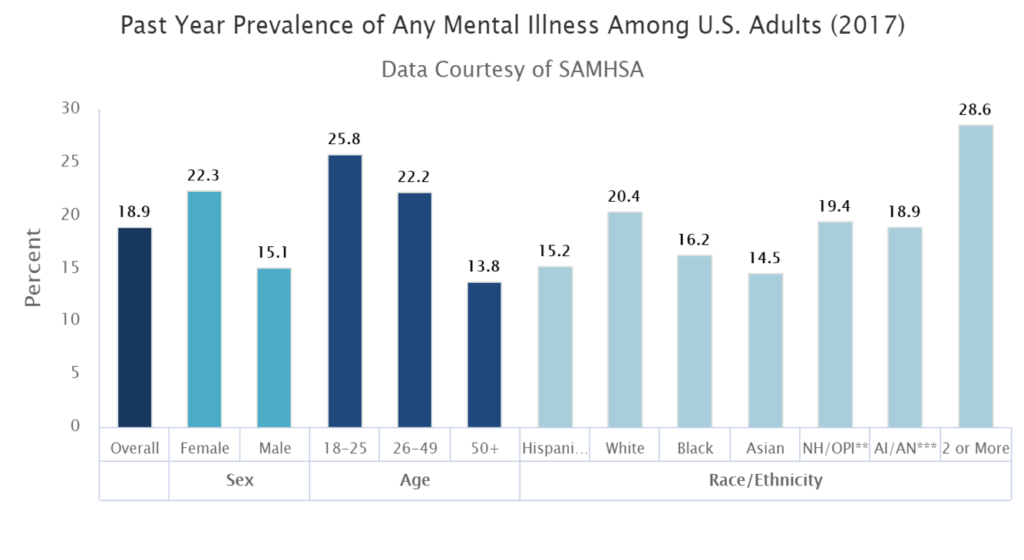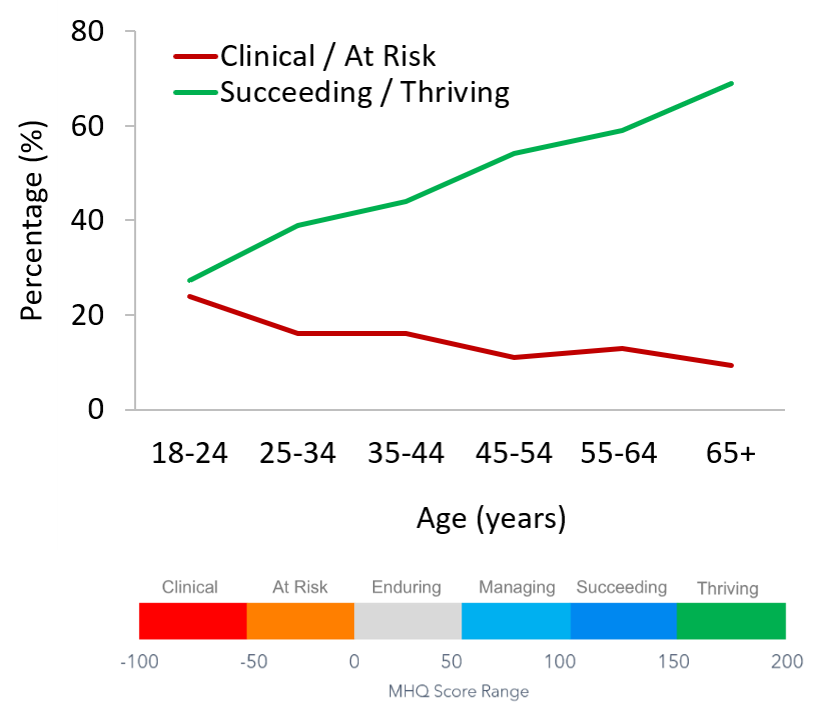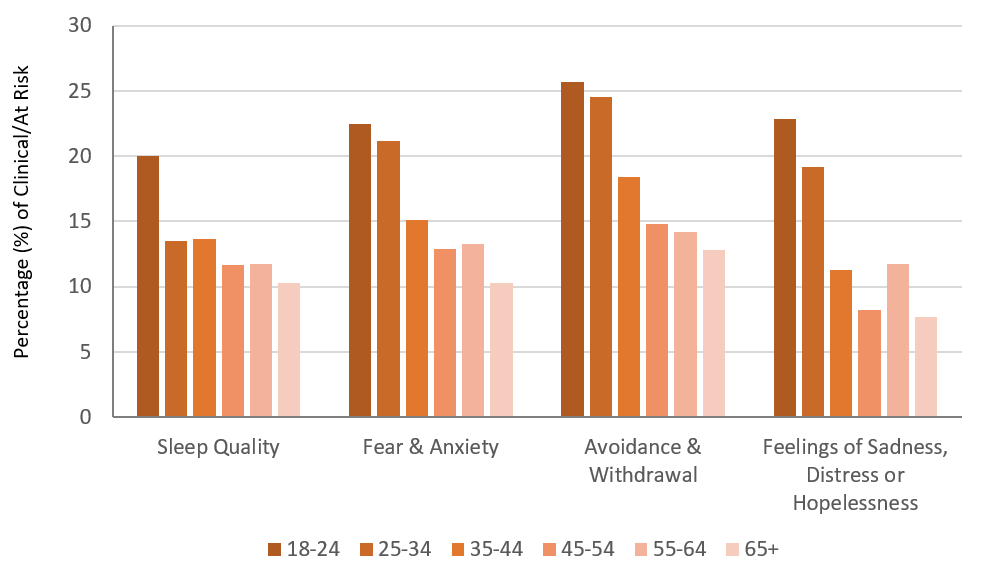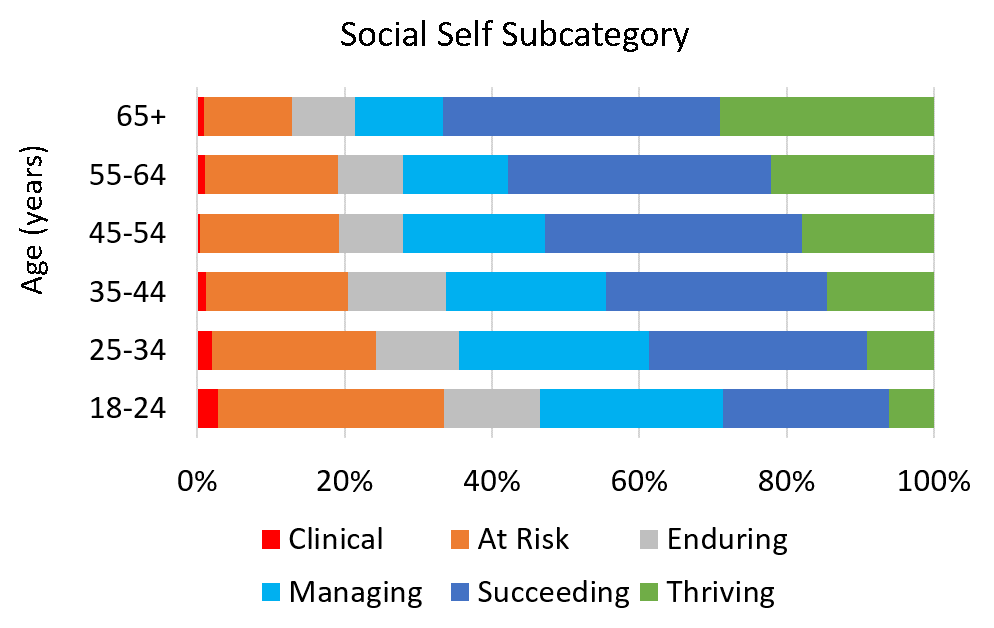Young adults are more likely to experience challenges to their mental health and wellbeing. What are the possible driving factors?
Young adulthood can be a time of incredible growth and change for young people. However, it can also be a stressful time, which can lead to mental health issues. Young adults (18-25 years old) may need more resources and support as they enter the “adult” world. However, what do mental health issues look like in young adults, and how can we figure out the best ways to support them?
Prevalence in Young Adults
Mental illness is more common in young adults than older individuals. The National Institute of Mental Health reports that young adults have higher rates of mental illness compared to their older counterparts. The chart below shows different prevalence rates based on sex, age, and race/ethnicity.

The Global Mind Project shows similar trends. Based on data from the Mental Health Quotient tool, young adults have the lowest overall mental well-being scores among all age groups. The differences are especially stark when comparing young adults’ outcomes and adults over the age of 65:
- 24% of young adults appeared in the At-Risk/Clinical category, compared to just 9% of seniors
- Only 27% of young adults appeared in the Surviving/Thriving category, compared to 69% of seniors.

Common Symptoms
The MHQ measures six subcategories of well-being. Young adults have the lowest scores for Social Self and Mood and Outlook.
- Mood and Outlook refer to a person’s “ability to manage and regulate emotions effectively.”
- Social Self refers to a person’s “ability to interact with, relate to, and see oneself with respect to others.”
In Mood and Outlook, more young adults scored in the At-Risk or Critical ranges than any other group. These young people primarily reported problems with a lack of sleep, followed by feelings of anxiety, avoidance, and sadness. Sleep deprivation can increase the likelihood that a person will experience symptoms of depression and anxiety.

The graph below shows the stark difference between young adults and older adults in Social Self scores. About 35% of young adults scored in the At-Risk and Clinical ranges compared to around 15% in the 65+ range.

Possible Factors
There are several reasons why young adults are experiencing more mental health challenges:
1) Academic Workload leading to lack of sleep
There has been a great deal of debate and discussion over the level of homework, academic pressure and early school timings that young people experience today in both school and college. All of these factors can lead to fewer hours of sleep that are directly linked to mood & outlook challenges.
2) Big Decisions
In their article about emerging adulthood, Wood and his colleagues remind us that young adults are going through massive amounts of change at this stage of their lives. They are making significant decisions about their education, careers, living situations, and relationships. All of these choices are a major part of how young adults develop their identities. These choices also shape how they see themselves compared to other people.
3) Brain Development
Young adults are also making these big choices while their brains are still growing. The decision-making part of the brain, the prefrontal cortex, continues to develop through a person’s mid-twenties. Also, some young adults may face more challenges because of childhood traumatic experiences. For instance, adults who were severely abused and neglected as children have smaller a prefrontal cortex than other adults. As a result, they may face more difficulty with decision-making and managing their emotions in young adulthood.
4) Living in an Uncertain World
Finally, to understand young adults’ mental health, we have to understand their environment. This generation has already witnessed significant events like terrorist attacks, school shootings, and the financial crisis of 2018. Academic expectations and pressure from social media are likely adding to their existing anxiety. Now, they are trying to navigate what is next for them in a pandemic. The coronavirus may create new mental health issues or make existing symptoms worse in young adults.
Moving Forward
Public policy changes can provide support for young adults, and the Affordable Care Act serves as an example. The ACA allows young people to stay on their parents’ health insurance until the age of 26. As a result, more young adults now have greater access to mental health services.
In addition, the MHQ data revealed that young adults scored well on measures of memory, curiosity, and empathy. Policymakers can use this information to figure out how to build upon young adult strengths as they transition into the “adult world.” However, we still need more data on this population to better target policy efforts.

